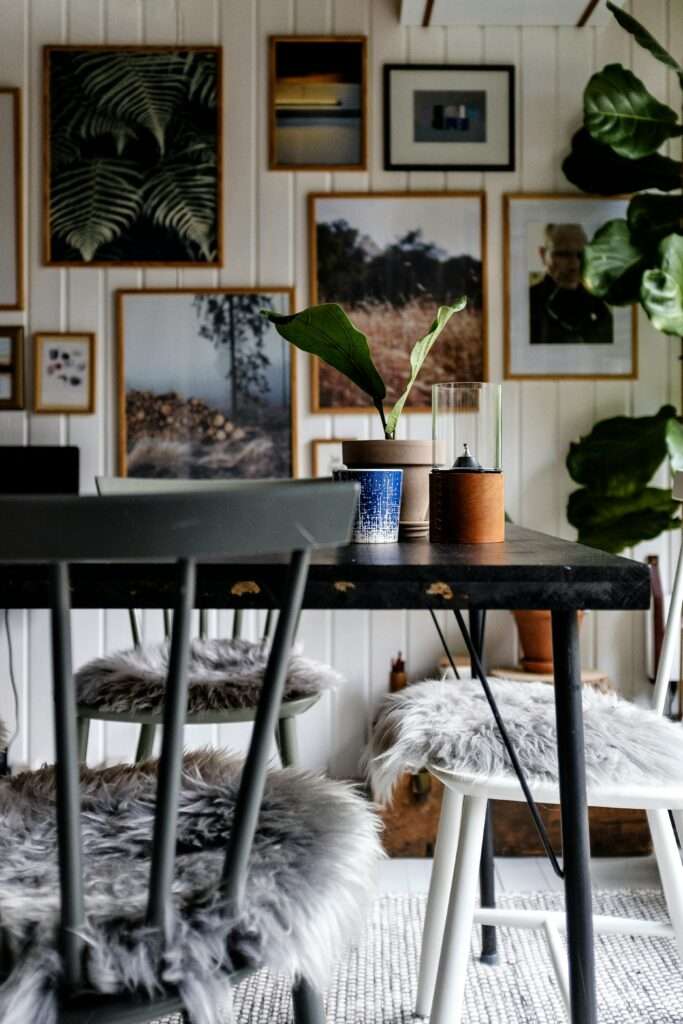Header: Courtesy of Jessica Shaw, Director of Interior Design at the NYC-based firm The Turett Collaborative
As we enter 2025, interior design is poised to reflect a blend of style, functionality, sustainability, and wellness. The trends of 2025 are as diverse as they are inspiring, catering to a wide range of tastes and preferences. Whether you’re drawn to minimalist serenity, rich textures, or the comforting embrace of cozy furniture and home wellness, there’s something for everyone in the year ahead. Let’s explore the top interior design trends shaping our homes in 2025.
Cozy minimalism: Japandi style
Japandi, the harmonious fusion of Japanese and Scandinavian design, continues to dominate in 2025. This trend emphasizes minimalism, natural materials, and neutral palettes, incorporating cozy elements like soft textiles and warm lighting. The result is a serene and inviting environment that promotes relaxation and well-being.
Japandi also celebrates timeless design influences, such as mid-century modern and Asian aesthetics, ensuring its longevity in the design world.

Jessica Shaw, Director of Interior Design at The Turett Collaborative, notes:
“Japandi style is gaining momentum, offering the perfect balance of comfort, ease, and timeless design. With its calming light wood tones and blend of Scandinavian and Japanese aesthetics, it feels iconic, rather than trendy. ”

Home wellness
The growing emphasis on health and wellness is transforming home design. From meditation nooks and yoga studios to luxurious, spa-like bathrooms, wellness spaces are becoming essential. Incorporating natural light, calming colors, and indoor plants enhances these areas, creating tranquil retreats for relaxation and rejuvenation. Even small touches, like a reading corner or a meditation alcove, can provide a personal sanctuary in busy households.
Integrated outdoor living
Blurring the boundaries between indoor and outdoor spaces remains a strong trend. Outdoor living areas, featuring kitchens, cozy seating, and weather-resistant decor, are designed to be as comfortable and stylish as indoor spaces. Natural materials like stone, wood, and clay enhance this seamless connection. Living walls, verdant gardens, and large windows further integrate nature into the home, creating a harmonious flow between the indoors and outdoors.
Rich textures
Flat surfaces are a thing of the past. In 2025, expect walls adorned with wallpapered ceilings, wood paneling, and decorative plaster finishes. These textures add depth, warmth, and interest to interiors, transforming ordinary surfaces into captivating focal points. Additionally, tactile materials like silk or linen wall coverings and plush upholstery create a cozy and inviting ambiance.
Earth tones
Earthy hues dominate the 2025 color palette. Rich browns, deep greens, terracotta, and ochre offer a grounding connection to nature. These tones promote tranquility and pair beautifully with natural materials for a cohesive, organic look. Subtle shades like soft greens and muted blues also bring a calming effect to interiors, making them perfect for bedrooms and living spaces.



Focus on comfort
Casually comfortable furniture is at the forefront of 2025 trends. Oversized sofas, deep-seated chairs, and rounded edges combine practicality with aesthetics. Breakfast nooks and cozy corners further emphasize comfort without compromising style. Designers are leaning into performance fabrics and ergonomic designs that cater to modern lifestyles while maintaining an elevated appearance.



Discreet technology
Seamlessly integrated technology is redefining modern living spaces. Hidden speakers, wireless charging furniture, and voice-controlled lighting are just a few examples of how tech is blending effortlessly with decor to enhance functionality without disrupting aesthetics. Smart home solutions are becoming more intuitive and less intrusive, ensuring they complement, rather than compete with, interior design.




Color-drenched interiors
Bold and saturated hues are making a comeback. Color-drenched rooms create dramatic and cohesive spaces where a single hue dominates in varying shades. This means everything from ceiling to walls to furniture and decor. Go monochrome with pastels, or pair these vibrant tones with neutral accents for a balanced look. This approach adds personality to a space and allows homeowners to experiment with daring color combinations.




Statement lighting
Lighting is no longer just functional; it’s an art form. Oversized pendants, sculptural lamps, and unconventional fixtures double as eye-catching design elements. Dim lighting options also allow homeowners to adjust the mood of a room effortlessly. Combining functionality with artistry, these lighting solutions elevate interiors and highlight architectural features.



Sustainable design
Sustainability remains at the heart of interior design in 2025. Designers are focusing on eco-friendly materials, vegan leathers, and non-toxic products. Reusable and durable items are also gaining traction, ensuring homes are both stylish and environmentally responsible. Upcycled furniture, energy-efficient appliances, and locally sourced materials are becoming staples in sustainable interiors.
Personalized spaces
In 2025, personalization is key. Spaces are becoming more tailored to individual tastes, with unique decor and bespoke furniture taking center stage. This trend encourages homeowners to express their personalities and create truly one-of-a-kind environments. From custom artwork to curated collections, the possibilities for personalization are endless.
In keeping with the rise of dopamine décor — an aesthetic characterized by focusing on styling your space to evoke a personalized, feel-good response —, we can expect to see an emphasis on expressing your identity, story, and culture in your space.
Jessica Shaw, Director of Interior Design at The Turett Collaborative, added:
“With the uncertainty of the political climate and the lingering effects of post-COVID life, people are craving spaces that feel uniquely theirs – spaces that reflect their personal DNA and provide a sense of comfort and belonging in an unpredictable world.”




The interior design trends 2025 highlight a collective desire for spaces that nurture comfort, reflect personal style, and prioritize sustainability.










